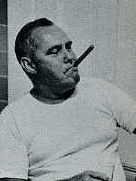JOHNSTON-WILLIAM
WILLIAM JOHNSTON

MOMM1

AN AMBUSH GOES AWRY
William Johnston was born on May 5, 1910, in Dunbarton, Scotland. He moved to the United States when he was two and his family settled in Dorchester, Massachusetts. Little has been recorded concerning his Navy career except for his service as a Motor Machinist Mate Second Class on Motor Torpedo Boat USS PT-109.
In Blackett Strait, south of Kolombangara in the Solomon Islands, the starless, moonless night of August 1-2, 1943, was profoundly dark, inky blackness. USS PT-109 stood at her station, one of fifteen PT boats that had set out to engage the well-known "Tokyo Express," the Japanese navy's supply convoy to soldiers fighting the advance of U.S. forces in the islands farther south. When the patrol came in contact with the Tokyo Express—three Japanese destroyers acting as transports with a fourth serving as escort—the encounter did not go well. Thirty torpedoes were fired without damaging the Japanese ships. Boats that had used up their complement of torpedoes were ordered home. The few that still had torpedoes remained in the strait for another try. What then transpired may well be the most famous small-craft engagement in U.S. naval history and surely the only time a vessel skippered by a future American President would be sunk in a collision with a Japanese ship.
PT-109 was one of the boats left behind. The boat’s commander, LTJG John Fitzgerald Kennedy, future U.S. President, rendezvoused his boat with two others. The three boats spread out to make a picket line across the strait. Unfortunately, none of the three PT boats was equipped with radar. At about 2:30 in the morning, a shape loomed out of the black darkness about three hundred yards off PT-109's starboard bow. Kennedy and his crew first saw a luminous wake and believed it was another PT boat. When it became apparent that it was a Japanese destroyer, Kennedy attempted to turn to starboard to bring his torpedoes to bear but there was not enough time. The Japanese destroyer, later identified as the AMAGIRI, had begun a 400-mile high speed run for Rabaul when a lookout spotted something small dead ahead. Correctly believing the unidentified boat to be an American PT boat the AMAGIRI’s commanding officer ordered the helmsman to speed directly toward the object. PT-109 was struck by AMAGIRI just forward of the forward starboard torpedo tube, ripping away the starboard aft side of the boat. Most of the crew were knocked into the water. The one man below decks miraculously escaped, although he was badly burned by exploding fuel. PT-109 had been sliced in half and the aft portion of the boat quickly sank.
MOMM2 Johnston was reportedly asleep on deck at the time of the collusion and was one of the crewmembers knocked overboard. He later remarked that he saw flames and the destroyer’s propeller as he was thrust into the water. There the turbulence turned him over and over, held him down and drubbed his ribs. Fortunately, he was wearing a life vest as he was a non-swimmer. When he finally surfaced he said the water was like a river rapids. Although the bow portion of the boat was floating, the surrounding water was largely covered with burning fuel. Fear that what remained of PT-109 would go up in flames drove Kennedy to order the men who still remained on the wreck to abandon ship. When the fire began to subside, Kennedy sent his men back to what was left of the boat and helpful crewmembers pulled Johnston with them. The crew took stock and discovered that two crewmembers had disappeared in the collision, very likely killed at impact. All the men were exhausted, several were injured and some had been sickened by the fuel fumes. There was no sign of other boats or ships in the area and the men were afraid to fire their flare gun for fear of attracting the attention of the Japanese who were on islands on all sides. Although the wreckage was still afloat, it was taking on water and it capsized on the morning of August 2. After a discussion of options, the men abandoned the remains of PT-109 which was slowly sinking and started swimming for an islet nearby.
The survivors managed to reach an uninhabited islet about three miles from the sinking. They had lashed Johnston and another crewman to a plank which they pulled and pushed as they slowly proceeded about four hours to dry land. On the islet they found there was no drinking water and the only food was coconuts. LTJG Kennedy left the group several times to swim to nearby islets looking for assistance. With the help of friendly natives, word of their plight reached authorities and after several days of eluding the Japanese the PT-109 survivors were finally rescued. Unfortunately, during the ordeal MOMM2 Johnston had swallowed a large amount of gasoline and he passed out due to that and the fumes. He remained violently ill for several days after the sinking. After his rescue he was found to be unfit for further service and he was discharged from the Navy.
Following his discharge, William Johnston became a truck driver for 33-years with the Gulf Oil Company. He was also a member of the American Legion and the Masonic Lodge in New Hampshire. He died on July 5, 1968, and is buried at Wildwood Cemetery in Seabrook, New Hampshire, where his grave marker carries the inscription: MOMM1 - USNR - WORLD WAR II - PURPLE HEART.
Submitted by CDR Roy A. Mosteller, USNR (Ret)

